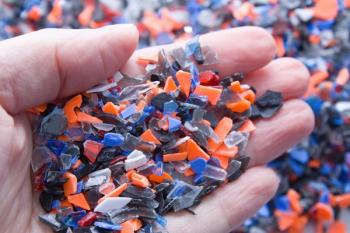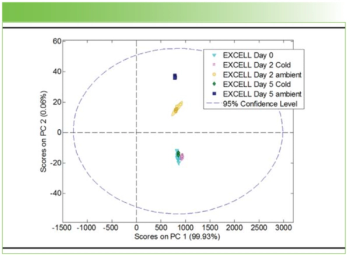
SuperCam Raman Spectroscopy Unlocks Jezero Crater’s Geological Secrets
Scientists detail the first 1,000 sols of spectroscopic mineral detections on Mars
A team of international researchers has provided an in-depth review of the SuperCam instrument’s Raman spectroscopic analyses during the first 1,000 sols of NASA’s Perseverance mission in Jezero Crater, Mars. Their findings highlight critical advancements in planetary exploration, revealing the mineral composition of the Martian surface with extraordinary detail (1).
Introduction
Since landing in Jezero Crater in February 2021, NASA’s Perseverance rover has been utilizing the SuperCam instrument suite to analyze the Martian terrain. Among its capabilities, SuperCam introduced Raman spectroscopy to planetary exploration for the first time, enabling remote identification of minerals at standoff distances of several meters (1,2). This technique, detailed in a study published in ESS Open Archive by Guillermo Lopez-Reyes, Jose Antonio Manrique, Elise Clave, and a team of researchers from multiple institutions worldwide, has provided critical insights into the geological history of Jezero Crater (1).
Raman Spectroscopy: A New Frontier in Mars Exploration
Raman spectroscopy is an analytical technique that detects molecular vibrations by measuring how laser light of a specific wavelength interacts with a sample. The method enables precise identification of minerals and molecular structures, making it a powerful tool for planetary exploration. However, conducting Raman spectroscopy in the harsh Martian environment posed significant technical challenges, including remote sampling, weak Raman signals, interference from environmental conditions, and the need for advanced data processing methods (1,2).
To address these issues, the SuperCam team implemented innovative strategies for data acquisition and post-processing. These efforts ensured that high-quality spectroscopic data could be collected despite the limitations imposed by distance, laser power constraints, and the fine-grained nature of Martian surface dust and soils (1,2).
Key Findings from 1,000 Sols of Data
During the first 1,000 sols (nearly three Earth years) of the Perseverance mission, SuperCam analyzed approximately 500 points across 60 geological targets, providing crucial mineralogical data. Among the most significant detections were as follows (1).
- Olivine and carbonates: These minerals, found in Jezero’s crater floor and delta regions, support hypotheses about past aqueous environments and potential habitability.
- Sulfates and perchlorates: Identified on both abraded rock surfaces and natural formations, these salts indicate historical water activity and may provide clues to past climate conditions.
- Anhydrite: Detected in high concentrations, particularly in the Reids Gap region, where Raman spectra showed exceptionally strong signals.
The study also highlights the first-ever Raman spectrum obtained from another planetary surface—acquired from the diamond sample of the SuperCam Calibration Target (SCCT) on Sol 13 of the mission (1).
Overcoming Challenges in Data Processing
Given the unique challenges of conducting Raman spectroscopy on Mars, the SuperCam team developed an advanced data processing pipeline. Raw spectral data undergoes multiple stages of refinement, including artifact correction, noise reduction, and calibration. A persistent issue, referred to as the “fiber bump,” is caused by backscattered laser light interacting with the instrument’s optical fiber. This artifact, primarily affecting signals in the 200-500 cm⁻¹ range, required specialized correction techniques to ensure accurate mineral identification (1).
The researchers also experimented with optimizing laser shot counts and exposure settings to enhance signal-to-noise ratios. They found that nighttime operations, conducted at lower temperatures, significantly improved spectral quality, though these activities required careful energy management due to the constraints of Martian nights (1).
Implications for Future Exploration
The success of SuperCam’s Raman spectroscopy demonstrates its immense potential for future planetary missions. By providing rapid, non-destructive mineral identification, Raman spectroscopy has proven invaluable for assessing the geological and environmental history of Mars (1,2).
The study’s authors, representing institutions such as the Universidad de Valladolid (Spain), the Deutsches Zentrum für Luft- und Raumfahrt (Germany), Los Alamos National Laboratory (USA), and several leading research organizations, emphasize that continued refinement of spectroscopic techniques will be crucial for future missions to Mars and beyond (1).
As Perseverance advances into new regions of Jezero Crater, SuperCam’s Raman capabilities will remain a key asset in unraveling the planet’s past and assessing its potential to have hosted life. The findings from this study not only enhance our understanding of Martian mineralogy but also pave the way for more sophisticated analytical techniques in the search for extraterrestrial life (1,2).
References
(1) Lopez-Reyes, G.; Manrique, J. A.; Clave, E.; et al. SuperCam Raman Activities at Jezero Crater, Mars: Observational Strategies, Data Processing, and Mineral Detections During the First 1000 Sols. ESS Open Archive 2025, February 25. DOI:
(2) Wiens, R. C.; Maurice, S.; Robinson, S. H.; Nelson, A. E.; Cais, P.; Bernardi, P.; Newell, R. T.; Clegg, S.; Sharma, S. K.; Storms, S.; Deming, J.; Beckman, D.; Ollila, A. M.; Gasnault, O.; Anderson, R. B.; André, Y.; Angel, S. M.; Arana, G.; Auden, E.; et al. The SuperCam Instrument Suite on the NASA Mars 2020 Rover: Body Unit and Combined System Tests. Space Sci. Rev. 2021, 217 (1), 1–87. DOI:
Newsletter
Get essential updates on the latest spectroscopy technologies, regulatory standards, and best practices—subscribe today to Spectroscopy.




